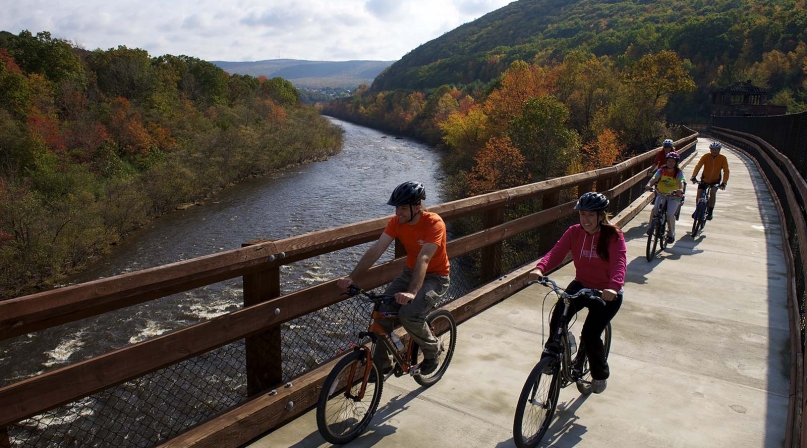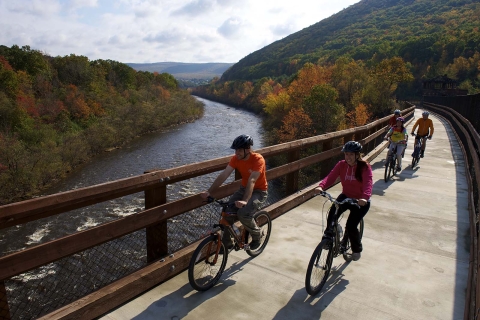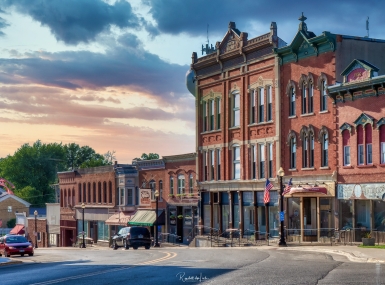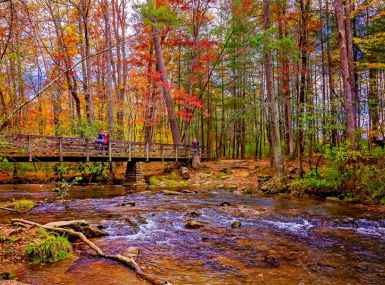Counties shape economy in Pocono region
Author
Upcoming Events
Related News

Key Takeaways
What does the Poconos have to offer?
“Natural beauty,” according to Chris Barrett, president/CEO of the Pocono Mountains Visitors Bureau.
The Pocono Mountains region in northeastern Pennsylvania encompasses 2,400 square miles of mountains, waterfalls, rivers and lakes. For decades, the four-season destination has been known as the “Honeymoon Capital of the World.” Now, the region and the four counties it incorporates — Monroe, Carbon, Wayne and Pike — are using that natural beauty in different ways to benefit their local economies.
Barrett explained that the region’s reputation of being a popular honeymoon destination started in the 1940s, when soldiers returned from World War II.
The area started to decline in the late 1980s after the deregulation of airlines and the addition of cruise lines, he said.
The Poconos still have classic resorts that have survived as “legacy attractions,” but now the region is focusing on indoor waterparks geared to families, convention center space targeted to business travelers and outdoor activities for sports enthusiasts, Barrett said. In the mid-2000s, the Great Wolf Lodge, an indoor water park and hotel, moved to the area and began a new kind of tourism.
“The region has been very, very good at reinventing itself in times of adversity,” he said.
The economic impact of tourism, which is the largest industry in the region, exceeds $1 billion, according to Barrett.
The Pocono Mountains Visitors Bureau collaborates with counties to attract more people to the area. Barrett said he meets with county commissioners every 90 to 180 days and frequently sends county clerks information regarding tourism in the Poconos.
“We’re meeting with our state and local officials so we’re trying to just communicate as much as possible and to us, outreach is important,” Barrett said.
Monroe County is home to numerous Pocono attractions including Kalahari, the country’s largest indoor water park, the Great Wolf Lodge, Camelback Mountain Resort and the Delaware Water Gap.
Monroe County Commissioner John Moyer said the county has been able to benefit from Pennsylvania’s hotel tax, which distributes money to a recognized tourist promotion agency, such as the Pocono Mountains Visitors Bureau. Counties may retain an administrative fee from hotel tax revenues, which Moyer said Monroe County uses to improve land for recreational purposes.
The Pocono Mountain Economic Development Corporation (PMEDC), an organization based in Monroe County, works to retain and attract businesses.
County officials appoint board members to the PMEDC. The organization also provides financial assistance to tourism properties, according to Chuck Leonard, executive director of the PMEDC.
While tourism is the major industry and largest employer in Monroe County, manufacturing is the largest generator of GDP, he noted.
The county’s largest manufacturing employer is Sanofi Pasteur, the largest supplier of the influenza vaccine in the world.
Leonard added that part of the evolution of the Poconos region is the diversification of the economy.
“While our focus is not always on tourism, we’re trying to do manufacturing and other things that we believe will ultimately be compatible with tourism,” he said.
Monroe County collaborates with Wayne and Carbon counties to publish a magazine through the PMEDC that shares positive economic development stories happening in the region.
“Our view is by maintaining open dialogue and working together, we enhance our ability to succeed,” Leonard said.
In Carbon County, Kathy Henderson, the director of Economic Development for the Carbon Chamber and Economic Development Corporation, said Carbon County’s economic drivers also include tourism and manufacturing, with more than 50 manufacturers located in the county.
The county seat of Jim Thorpe is a major tourism destination, with the Lehigh Gorge scenic rail and other outdoor activities including biking, white water rafting and kayaking.
“I think what has happened with a lot of businesses as well is people really love to live, work and play in Carbon County,” said Marlyn Kissner, executive vice president of the northern region of the Greater Lehigh Valley Chamber of Commerce.
“So, the folks that really love the outdoors and have that ability to open up shop or attract employees because of our backdrop is a big strength of our economic development.”
Carbon County Commissioner Wayne Nothstein said the county partners with regional organizations including the Pocono Counties Workforce Development Board, the Pocono Mountains Visitors Bureau and the County Commissioners Association of Pennsylvania (CCAP) to improve the region’s economy.
He added that the county has good relationships with the other counties in the region including Wayne County, which shares similar economic drivers.
Wayne County Economic Development Corporation Executive Director Mary Beth Wood said the county has created a group called Wayne Tomorrow, which focuses not only on economic development, but also county government, the workforce, infrastructure and technology.
With Wayne County sharing a border with New York, Wood said the county’s proximity to other states, including New Jersey, is also beneficial to its economy.
For tourists, the county has a train car that rides along the Lackawaxen River, kayaking, fishing and hunting, as well as attractions at Lake Wallenpaupack.
Wood said Wayne County also collaborates with the Pocono Counties Workforce Development Board, CCAP and the Pocono Mountains Visitors Bureau.
“We always look at individual counties, but we always think regionally here,” she said. “We think Wayne County is really at one of the forefronts of looking at the regional economy.”
The four Pocono counties also collaborate through the Northeastern Pennsylvania Alliance, a regional community and economic development agency which serves seven counties in northeastern Pennsylvania.
Carbon County’s Henderson said the Alliance allows counties to pool their resources to attract businesses not just to their own county, but to the region.
“Together, we’re stronger in working that way than if we would be trying to go at it alone,” she said.

Attachments
Related News

Counties and Railroads: Shared Priorities for the Next Surface Transportation Bill
County leaders from across the country have a vital opportunity to ensure their infrastructure priorities are front and center.

House reintroduces bipartisan legislation to level playing field for rural communities
House reintroduced the Rural Partnership and Prosperity Act, bipartisan legislation intended to advance economic development in rural counties and overcome barriers to obtaining federal funding and resources.

Podcast: Eastern Tennessee counties invest in tourism during shutdown
Sevier County, Tenn. refused to let the government shutdown devastate its fall tourism draw—Great Smoky Mountains National Park. County Mayor Larry Waters describes the lengths he and his neighbors went to keep the park open. And NACo Chief Government Affairs Officer Mark Ritacco offers an outlook on what counties can take away from the shutdown and into the future.
